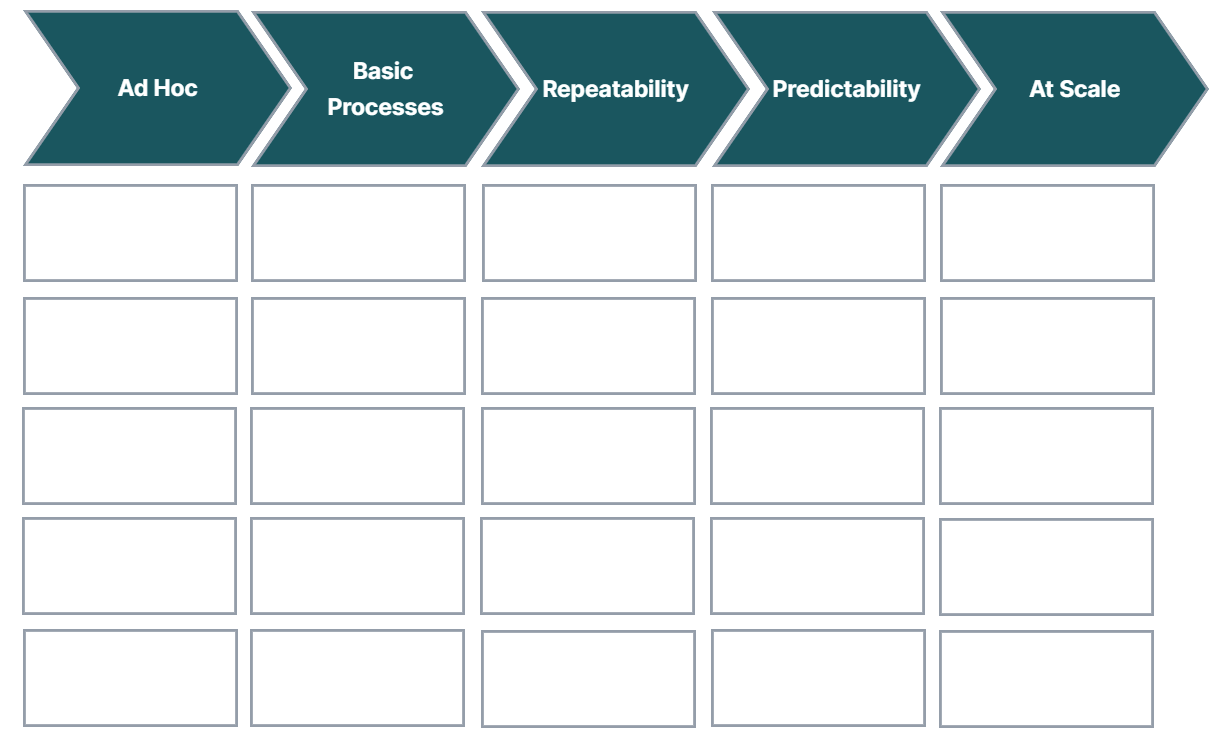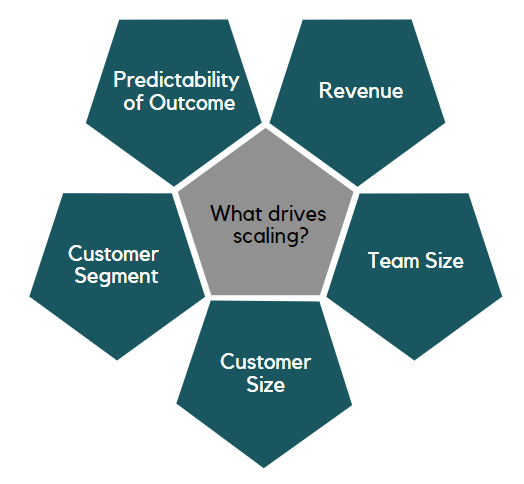Arthur Nobel
The T2D3 (triple, triple, double, double, double) acronym has become a well-known goal in the startup scene for achieving unicorn status. Formulating the goal can be easy, but realizing such tremendous revenue growth is notoriously difficult.
A study from Dealroom shows that about 16% of the companies that raise a seed round manage to raise a Series B investment, and only about 7% of those that raise seed funding raise a Series C investment.
This statistic is partially explained by a lack of a good organizational framework for scaling companies across seed to Series C. There is a lot of great content on the startup phase (getting to product-market fit) and success stories (raising hundreds of millions of dollars and multibillion dollar exits), but there is little available on how founders can grow a company from $1 million to $25 million in annual revenues (broadly defined as the Series A, B and C stages).
Based on 47 interviews with industry experts including Sean Ellis, Mark Roberge, Bill Macaitis, Micha Breakstone and Brian Requarth, desk research and our own experience as founders and investors in Series A to C companies, we have derived three major insights about how to scale a company from the organizational perspective. Here’s our framework:
Scaling is a continuum with maturity stages
A fast-scaling company with revenue of $5 million revenue has different scaling needs compared to a fast-scaling startup with $15 million in revenue. The concept of “maturity stages” for scaling a company can be useful to address the different needs.
The most common “maturity stages” of scaling a company are:
- Ad hoc.
- Basic process.
- Repeatable process.
- Predictable process.
- At scale.

Typically, for a seed-stage company, everything is developed in a more or less ad-hoc manner. At the Series A stage, it’s more about developing repeatable processes. Series B and C are about predictability of outcomes. Beyond Series C, it’s about doing everything at scale.
Of course, this is a companywide view. As we argue below, this can be different for individual departments. For example, a company at a “repeatability” stage that generates inbound leads through digital marketing efforts and has an enterprise sales department will often have a much more mature marketing department compared to sales.
The takeaway is to initially figure out in which stage your company and departments are in and only do what is required for that stage.
The challenges to scaling
You scale a company, from an organizational perspective, by overcoming numerous challenges. We believe that these challenges can be largely categorized into five buckets:
- KPIs and data.
- People.
- Documentation and enablement.
- Processes.
- Tooling.
We believe it is best to approach these challenges on the departmental and subdepartmental levels to make it workable.
KPIs and data
Data-informed decision-making is particularly important in the T2D3 journey. It is important to realize that different KPIs are relevant at different stages. First, focus on the right metrics for your stage. An LTV:CAC metric (lifetime value to acquisition costs) is less relevant for a seed company than retention.
Then, identify the metrics that are important in the next stage of your business, so that you can collect data upfront. If you don’t know which channel or market brings you the most bang for your buck, you won’t scale efficiently.
People
Challenges on the human resource front came up most frequently in our interviews. Here are a few problems encountered frequently.
It’s important to pace your hiring rather than hire everyone right after closing your funding round. This helps to build talent pools and allows organizations to “swallow” the influx of talent. We recommend a “stop-and-go” strategy, where you increase the efficiency per employee before further ramping up the team. Keeping track of your revenue per employee will help here.
You’ll need different kinds of people at each stage. People needed in early-stage companies have a “T-shape” profile — a broad skill set, but not in-depth — whereas people later on move more and more toward an “I-shape” profile — a narrow skill set, but in-depth. Also, employees’ risk perception and ability to “invent” tend to change.
Try to find a balance between talented newbies and people who have done it before. By the latter, we mean hiring people who have experience with the stage 12-24 months ahead of your current stage. Experienced employees recognize upcoming challenges and know how to deal with them.
Silos are inevitable when a company grows. In earlier stages (<30 FTE) organizational silos occur less frequently, but once you grow in headcount and raise a big round with ambitious targets for the individual departments, it’s easy to end up in silos. It’s important to introduce shared metrics between departments so that they optimize their activities aligned with the company goal.
Documentation and enablement
Documentation is important.
João Graca, founder and CTO of Unbabel, told us that he created a dummy variable in the code without any purpose. However, a year down the line, the context for this variable was lost, which resulted in people in the engineering department feeling uncomfortable amending this dummy variable. This could have been avoided with proper documentation.
In addition, enablement is important. Creating standardized documentation is crucial to being able to provide a standardized high-quality experience and gain efficiencies. This is not an argument for becoming a “paper-driven” organization. However, having enablement material and documentation in place is crucial to continue scaling.
Processes
The “P-word” is widely disliked by many founders and ventures. However, as complexity increases and compliance requirements emerge, systems need to be put in place in your business to make it a machine. However, it is important to start designing processes at the right time. Our contributors agreed on reaching the 20 FTE mark before adopting an organizational OS to prevent things from falling apart.
We challenge founders and operators to define, per department, which processes are necessary for which maturity stages. This helps the organization look ahead and be prepared for the next phase of growth.
Tooling
As software investors, we obviously love this point. As you add systems to your business with growth, you need tools in place to turn your company into a machine.
It’s important to realize that the tool stack of a company also depends on its current stage. For example, early on, sales are often documented using software like Excel or Pipedrive. After hiring five or more sales reps, we often see companies introducing Hubspot and later on switching to Salesforce. As your company changes every 6-12 months, don’t be surprised if you have to change your tech stack every 12-24 months. There is no way to be smart about this.
You also need to have clear “tool owners” and work with individual tools in the early stages while your company moves toward a unified stack later on. Avoid overcomplicating stuff in the early stages. It’s fine to have separate marketing and sales tools, but later on, you might want to work with a suite and control everything end-to-end.
As always, it’s important to build a tool roadmap so that you will have the right tools for the next stage of your business.
Scaling isn’t one-size-fits-all
Scaling for a company targeting consumers will be different from companies that sell software to large enterprises. We don’t believe in a one-size-fits-all approach to scaling. More importantly, we are often skeptical about “point-based advice” that is given in relation to scaling a company. Though these are given with the right intentions, they are usually hard to put into practice in a different context.
We believe that understanding what drives scaling is more helpful for founders. When you define different maturity levels, it is very important to know what the entry criteria are to move to the next stage of maturity.
We have wrapped our heads around the question of what drives scaling and have defined the following most common scaling drivers: Number of people, number of customers, revenue, customer segment and predictability of outcomes.

Our secrets to scaling
Our first recommendation is to build a strong support network. Surround yourself with colleagues, founders, operators, investors and advisers who are 12-24 months ahead of you. Of course, it goes without saying that you need mental support from family, friends, mentors and coaches, but that’s a topic for another conversation.
Our second recommendation is to hire a head of Scaling who reports to the COO. This person will focus on preparing the company for the next 6-12 months as opposed to managing current operations. This is particularly relevant in the pre-Series B stages, as companies tend to hire strong functional leaders who do not necessarily have the same conceptual thinking skills that a seasoned leader or McKinsey-like consultant might.
However, this skill set is very important for companies to prepare for the next stage. Additionally, it is important to have someone accountable for scaling and to avoid the trade-off of preparing for scaling versus running the business.
The third recommendation is to build a scaling roadmap. We’re always surprised that companies build a product roadmap, but don’t have a scaling roadmap.
Below are a few steps and visualizations to help you get started:
- Identify the (sub)departments for which you’re preparing your scaling roadmap (e.g., sales).
- Brainstorm what the maturity levels per (sub)departments look like based on the six dimensions we mentioned earlier.

Image Credits: Knight Capital - Identify the driver for each maturity stage.

Image Credits: Knight Capital - Decide what maturity stage is needed for each (sub)department in the next 18-24 months.

Image Credits: Knight Capital - Identify which actions each (sub)department has to take.

Image Credits: Knight Capital
You can access the framework here.































Comment